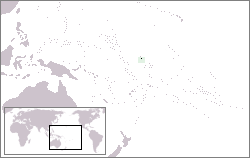Baker Island is an uninhabited unincorporated territory of the United States—one of the smallest U.S. Minor Outlying Islands. It is in Polynesia, a region of the Pacific Ocean, north of Kiribati, roughly halfway between Hawaii and mainland Australia.
Understand
edit|
Or maybe not
In the early 2000s, a writer of "alternate histories" put up a web site which presented itself as the official site of the government of the "Republic of Baker Howland and Jarvis", portraying a bustling tourism destination, including a fake CIA World Factbook article providing statistics for the island nation. The web site is no longer online, but puzzled more than a few armchair travelers. |
History
editThe US took possession of the island in 1857, and its guano deposits were mined by US and British companies during the second half of the 19th century. In 1935, a short-lived attempt at colonization was begun on this island—as well as on nearby Howland Island—but it was disrupted by World War II and thereafter abandoned. The island is now a National Wildlife Refuge run by the US Department of the Interior; there is a day beacon near the middle of the west coast.
Landscape
editLow, nearly level coral island surrounded by a narrow fringing reef. Treeless, sparse and scattered vegetation consisting of grasses, prostrate vines, and low growing shrubs; primarily a nesting, roosting, and foraging habitat for seabirds, shorebirds, and marine wildlife.
Flora and fauna
editAnimal life includes ruddy turnstones, bar-tailed godwits, sanderlings, Pacific golden plovers, albatross, bristle-thighed curlews, Gray Reef Sharks, Spinner dolphins, monk seals, seals, hermit crabs, Green turtles and hawksbill turtles.
Climate
editEquatorial: scant rainfall, constant wind, burning sun.
Get in
editGet around
editThe island is only 2.1 km2 (0.81 sq mi), you should easily be able to get around its entire area on foot.
Fees and permits
editPublic entry is by special-use permit[dead link] from US Fish and Wildlife Service and generally restricted to scientists and educators.
See
editThere is a cemetery and remnants of structures from early settlement near the middle of the west coast.
Do
editBirdwatching and other wildlife observation is one of the few reasons to come here besides the sheer novelty.
Buy, eat and drink
editThere is no economic activity on Baker Island.
Sleep
editThere is no accommodation on Baker Island.
Stay healthy
editThere are no natural sources of fresh water on Baker Island—come with some distilled water and purification tablets. The island is barren and exposed so be cautious of the sun and elements.
Stay safe
editYou are miles from any kind of emergency services here so come prepared and don’t do anything stupid or needlessly risky.
Go next
editHowland Island is relatively nearby.



